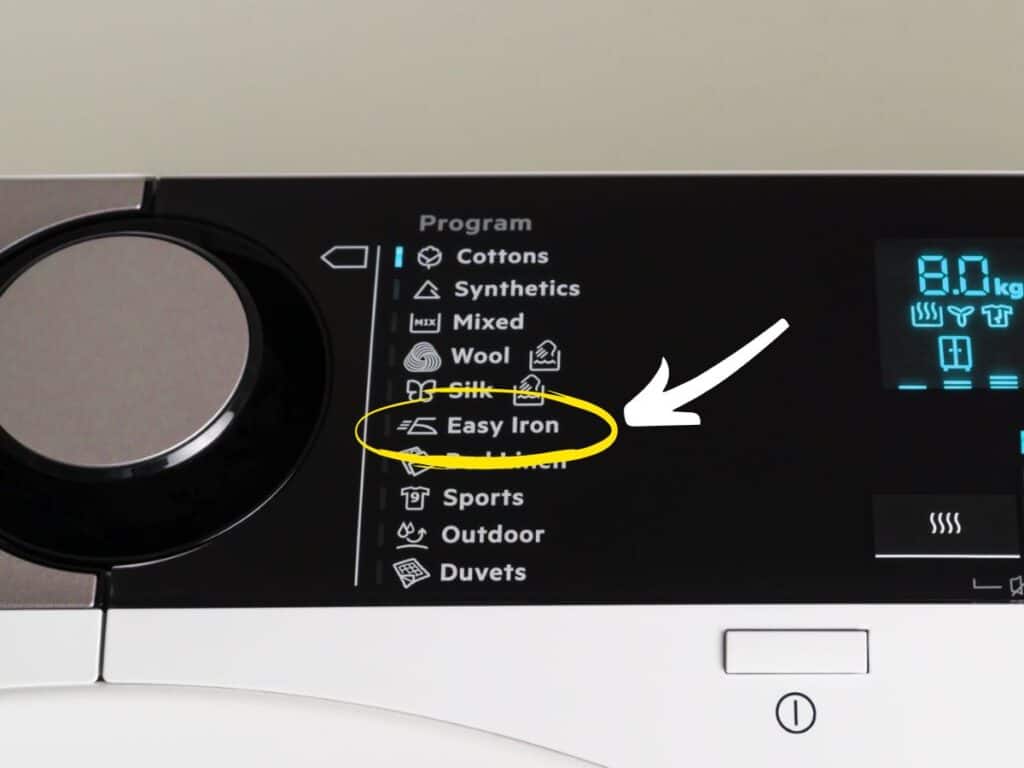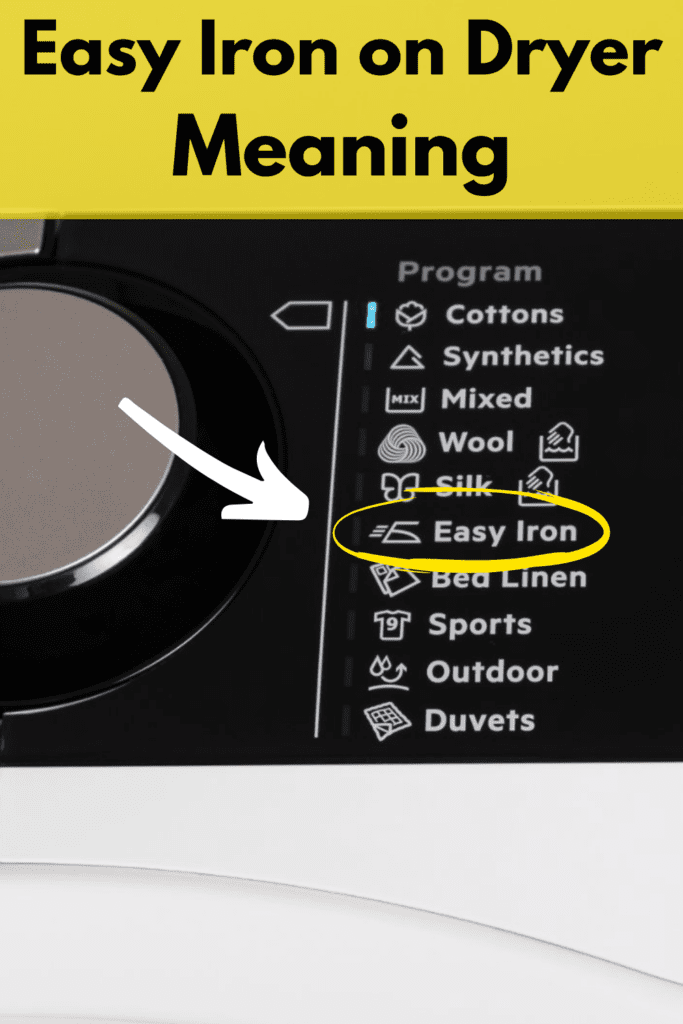Like washing, ironing is not a fun chore for many people. Watching a pile of clothes requiring ironing is in itself uninspiring.
However, as it is an essential task in most homes, there are a few things you can do to make it likable. And that is where easy iron on a dryer comes in.
Read on as we explore this feature and how you can use it to make your ironing work stress-free.
Understanding Easy Iron on Dryers
As the term implies, when drivers are set to ‘easy iron,’ the drying is meant to condition the clothes for easy ironing. This happens by drying the clothes only up to certain levels to retain some moisture. This allows easy ironing without the need for further wetting with water.
This setting is meant to relax the clothes, reduce the creases, and make it easy to remove and flatten the creases as you iron. This feature not only makes your work easy but also shortens the ironing time.
Remember that this setting is only meant for clothes you intend to dry immediately. If not so, you can set them to other settings that will dry the clothes to a more appropriate dryness level.

Other Dryer Settings
Easy iron is by no means the only dryer setting. There are others you should explore if you want to get the best benefit from your dryer. Let us look at them and find out how they can benefit your laundry.
Child Lock
Like most electronic items, some dryers may have this feature whose purpose is to prevent children from operating them.
Activating this setting will prevent children from opening the dryer when it is in operation.
If you have hyperactive children, start activating this program to prevent them from getting harmed.
Anti-crease Setting
If you activate this setting, it means dried clothes will not be compacted and creased. To prevent this, the machine is designed to keep turning the clothes around once the drying cycle has ended.
This can be helpful for those who know the clothes might overstay in the dryer.
Timed Dry
This helps you to decide the period over which the drying should happen. For example, you could decide to set the dryer to run between 30 minutes to 60 minutes.
Depending on the control types, all you have to do is dial or key in the timing, and the dryer will stop once the time you’ve selected lapsed.
But remember, you’ve to be careful with timing when drying the delicate to avoid ruining them.
For these types, before choosing the drying setting, it is recommended to check out the manufacturer’s care instructions.
Cotton Dryer Settings
If your machine has the “cotton” setting, it is specifically for cotton clothes. Generally, cotton requires a much higher level of heat in order to dry well.
For that reason, you shouldn’t use this setting unless you know the item you’re drying requires a higher level of heat to dry to avoid damaging them.
Delicate Settings
You use this setting when you are drying delicate fabric items. Examples include silk, rayon, linen, chiffon, and wool.
Under this setting, garments are dried under much lower temperatures, timed to last longer in consideration of the delicate nature of the clothes.
Besides the temperature and timing setting, the load size is also important. For the best results, only put half the dryer load capacity.
Sportswear
This setting is designed for activewear clothes. These clothes have special drying needs to avoid getting damaged.
Most of them are made of unique fabrics such as spandex which shouldn’t be exposed to extreme heat to avoid shrinkage.
Usually, with such clothes, air drying is the most appropriate method to use. But if you must use the method, then choose this setting.
Cupboard Dry
This is among several names describing the setting in which the clothes come out with the utmost dryness. Another name describing the same dryness level is “ready to wear.”
While different manufacturers might have slight variations in the description, the bottom line is that clothes are ready for either the closet or immediate use at this level of dryness.
The type of dryer setting is long, and sometimes it varies depending on the manufacturer’s dryer design. So this list is by no means exhaustive.
Tips to Efficiently Dry Clothes
Spin More Than One Time
Not all clothes will be dried by a one-time spin. Some will require more depending on the level of clothes wetness.
Be sure to add an extra spin for the heavy-wet clothes so as to dry the clothes faster and to durable levels.
Clean the Fluff Filter
Over time clothes lint and other debris will collect in the fluff filter. Without proper cleaning, the filter will get blocked and prevent the essential airflow required for the proper functioning of the dryer.
To clean it, you can remove the filter manually and use a vacuum cleaner to reach the obscure corners of the filter.
Sort Out Clothes Before Drying
Loading everything without considering the clothes’ fabric types will only result in a mess. For example, drying shorts, long sleeve shirts, brassieres, and pants together will only create an entangled yearn.
Worst case scenario is that you might end up with torn garment at the end of the cycle.
Match Fabric Type With the Dryer Setting
As we found above, every dryer setting is designed for specific fabric types based on the characteristics and the care requirements. Failure to do this will result in poor drying results.
Frequently Asked Questions
How Long Does a Tumble Dryer Take to Dry Clothes?
It takes an average of 40 minutes to tumble dry at normal load size. However, this may vary depending on, among others, the fabric types and the dryer efficiency.
For example, fabrics such as cotton will require a longer time and higher heat to dry clothes to cup dryness. In contrast, delicacies such as rayon and silk will only require a shorter period.
What Is Sensor Dry?
This refers to some dryers with sensors in their drum to help in timing the drying process. This helps the dryer to notice when the clothes have completed drying and switch it off irrespective of the setting cycle. It’s an effective energy saver.
Why Does My Dryer Take Too Long to Dry Clothes?
Many factors contribute to how long the drying process takes. How long the drying process takes depends on, among others, clothes’ moisture level, fabric types, and the dryer efficiency.
In general, dripping wet clothes and fabrics such as denim will take longer to dry. But the condition of the dryer is also critical. Clogged dryer vents restrict airflow, reducing the rate of drying.
I also wrote a guide on using easy iron on your washer that may interest you to read next.


I’m an expert wardrobe organizer and a bit of a clean freak. I created this website and its YouTube channel to share practical guides about laundry and organizing. My teachings have been featured in multiple large news publications, and I’ve self-published two wardrobe organizing books and an entire course on the subject.

